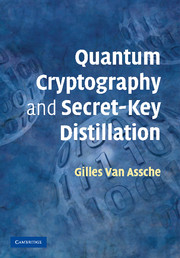Book contents
- Frontmatter
- Contents
- Foreword
- Preface
- Acknowledgments
- 1 Introduction
- 2 Classical cryptography
- 3 Information theory
- 4 Quantum information theory
- 5 Cryptosystems based on quantum key distribution
- 6 General results on secret-key distillation
- 7 Privacy amplification using hash functions
- 8 Reconciliation
- 9 Non-binary reconciliation
- 10 The BB84 protocol
- 11 Protocols with continuous variables
- 12 Security analysis of quantum key distribution
- Appendix symbols and abbreviations
- Bibliography
- Index
4 - Quantum information theory
Published online by Cambridge University Press: 04 August 2010
- Frontmatter
- Contents
- Foreword
- Preface
- Acknowledgments
- 1 Introduction
- 2 Classical cryptography
- 3 Information theory
- 4 Quantum information theory
- 5 Cryptosystems based on quantum key distribution
- 6 General results on secret-key distillation
- 7 Privacy amplification using hash functions
- 8 Reconciliation
- 9 Non-binary reconciliation
- 10 The BB84 protocol
- 11 Protocols with continuous variables
- 12 Security analysis of quantum key distribution
- Appendix symbols and abbreviations
- Bibliography
- Index
Summary
In this chapter, I will introduce the concepts of quantum information that are necessary to the understanding of quantum cryptography. I first review the main principles of quantum mechanics. I then introduce concepts that somehow translate information theory into the quantum realm and discuss their unique features. Finally, I conclude this chapter with some elements of quantum optics.
Fundamental definitions in quantum mechanics
In classical mechanics, a system is described with physical quantities that can take certain values at a given moment in time; we say that is has a state. For instance, the state of an elevator comprises its position and speed at a given time. As dictated by common sense, if the elevator is at a given height, it cannot be simultaneously found at another location. With quantum mechanics, things are fundamentally different and elementary particles can behave against common sense. For instance, a quantum system can simultaneously be in different levels of energy. This is not because our knowledge of the state of the system is incomplete: the behavior of the quantum system is consistent with the fact that it is in simultaneous levels of energy.
It would go beyond the scope of this book to describe quantum mechanics in detail. Instead, I propose a synthetic introduction suitable for the understanding of quantum cryptography. For a more detailed introduction, please refer to the books listed at the end of this chapter.
- Type
- Chapter
- Information
- Quantum Cryptography and Secret-Key Distillation , pp. 49 - 62Publisher: Cambridge University PressPrint publication year: 2006



